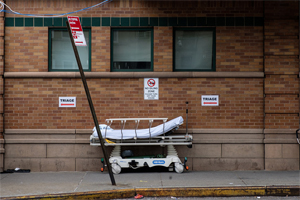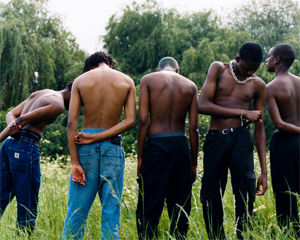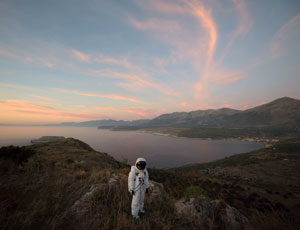With You All Along
John Haberin New York City
Covid New York and #ICPConcerned
Tyler Mitchell and John Akomfrah
Come fall, other museums have welcomed you back. The International Center of Photography would like you to know that it was with you all along.
It saw how much you feared and how much you cared during the worst of the pandemic and police killings. It asked five photographers to show how you much you depended on the care of others, as "Covid New York." It started a hashtag, #ICPConcerned, so that you and utter strangers could find common ground as well. George Georgiou watches, too, as spectators watch others, in "Americans Parade." Tyler Mitchell goes so far as to promise relief, with "I Can Make You Feel Good," but can you stand so much good cheer? You may not have to, with shows that only gain in poignancy from their hopeful titles— and John Akomfrah takes stock of the loss one year later in Chelsea, in a melancholy video. 
Hospital workers may still be at risk, but their protective gloves lie in the dirt. Will there be anyone to pick them up? Their images, by Jeenah Moon in "Covid New York," speak of absences, in a time of death. They may seem impersonal, to the point of documenting environmental hazards rather than people. Yet absences are always human stories, and the four shows are full of them, as photography so often is. Just do not expect to feel all that good.
Shut down and keep going
I should have known that a look back would be heartbreaking, for I was there with you, too. No wonder I keep trying to look ahead. Still, I had my doubts going in. I had seen those upbeat titles, and I was so used to conventional journalism and social media, with their false alarms and false hopes of coming together. You know what sells: man bites dogs, and then the cute little dog licks the man's wounds.
That is one reason for museums—because art can afford to tell the truth. ICP had found a home on the Lower East Side so soon before having to close after shows of political photography concerning sheer survival, women's portraiture and American lives, Henri Cartier-Bresson and photojournalism, and staged photography by Lewis Carroll. With "Public, Private, Secret" it watched others watching you. It draws on all those genres now, but the worst is not over yet. It is sad enough just to enter, through the center's tunnel-like first floor with no space for galleries. Exhibitions do not reach the third floor either this time out, and classrooms lie covered in white cloth as if for a funeral.
Still, ICP looks after its own. The photographers in "Covid New York" are alumni, and they went right to work. A show of just a few works apiece sticks to a single month, soon after the city all but shut down. To add to the sense of urgency and improvisation, four of five rely on inkjet prints, while Jeff Mermelstein gets two light boxes. The very term brings out the shortage of light last April, and they do not shy away from the darkness. If anything, it was bleaker than I care to remember.
Their New York really did shut down, even as people had to keep going. Jeenah Moon makes that a sharp contrast, between the gloves or the faceless Kips Bay towers bearing their "thank you" and, I shall guess, the hospital right behind it, where workers assemble for a group portrait. They must have lost those smiles the moment they stood apart. A trash collector pushes his cart past the Hotel Pennsylvania, and one can feel his burden and the hotel's lack of guests. The downtown PATH station by Santiago Calatrava holds only an American flag, as if for a fallen veteran. More than ever, the ribs of the Oculus look like the back of a predatory insect.
Essential workers for Yuki Iwamura appear more through their absence, in a uniformly low light. It shrouds a funeral home, a triage center, and empty hospital beds with a single worker in silhouette. Mermelstein keeps his sense of humor and of ordinary human courage, up to a point. Sidewalks can still display graffiti hoping that you will stay safe, even if the nameless writer is gone for good. Sarah Blesener humanizes the isolation, with a loving black couple in middle age. Titles speak of their reliance on community, even as her photos cut them off.
Gaia Squarci extends the role of text, with black-and-white images equal in size to the first-person accounts of their subjects. A man has seen a column of smoke above buildings that can no longer offer protection, and now so will you, while another has witnessed "a black hole where my corner deli used to be." A young woman with shuttered eyes appears through glass made more opaque by drops of water on "these nights." Still another is "watching my world shrink"—a reminder for her that "anything can be snatched away from anyone." One-way arrows offer direction, only those street signs have twisted and crossed.
Covid's eternal summer
Can anyone still find direction in a lockdown? Is there anyone left to to ask? #ICPConcerned shows people reaching out. They may be reaching out to touch photos on the wall, of people they cannot see—or to share the insistence that black lives matter and "I Am Human," too. They also reach beyond the April of "Covid New York" to the very week that the museum reopened in October.  They turn museum walls into a living calendar.
They turn museum walls into a living calendar.
Photos first posted to a hashtag do not sound promising, no more than iPhone photos in a show coming up. We all know the limits of social media or, for that matter, juried invitationals in art, but those months of collective longing are heartrending in themselves. "Americans Parade," in contrast, settles for crowds. George Georgiou photographs people gathered for a parade, neither rapt nor bored, on every conceivable public holiday and in more than half the states. Wall size and in black and white, they are watching spectators looking back—like Garry Winogrand at a space launch. If only they had more to say.
Tyler Mitchell was with you all along, too, if only you had been there to see. The sole returning show from ICP's opening on Essex Street, he still thinks of his work as "gut punching in its optimism," even now. He could be making up for lost months in art after Covid-19, but he was set to run out the year all along. Everything has changed in the interim but the exhibition. One can feel its optimism more than ever, but also that punch in the gut. "I Can Make You Feel Good" has become an African American's eternal summer, even as summer gives way to darkness and cold.
It still unfolds over several rooms in successive media. It starts with video on two screens in a mirrored room, an environment to itself. A video has duration, but the young black males basking in sunlight hardly move. After a room of large photos, video returns—this time in mid-ceiling. You may not see it right away, but you will if you look up toward the sun. Astroturf and black fencing convert the room into a comfortable backyard, but also a place of confinement.
Photos on light fabric wrap things up, hung from clothes lines along with socks and leisure wear. One can smell the fresh air as they sway with each passing visitor. Are the owners of the clothes still ready to play? Everything looks, smells, and sounds different now, after months of disease and mass protests. Mitchell might almost have anticipated them. Even in his mind, though, he may never break out.
Did the opening room have a soundtrack all along, in the first person? No doubt, and it speaks of fears that a black can never be smart enough—and might be killed just for having thick lips. Are the photos the same as ever, with the American crossings of "But Still, It Turns" coming up? No doubt, too, but now all I can see is a wish to be happy, even for men seen from the back as if awaiting the auction block. "I often think about what white fun looks like," he says, with a bow to cheap thrills in Ryan McGinley and Larry Clark. That must look different now, too.
Heart murmurs
Some days during the pandemic, it made little sense to leave home. On many more days, it took a long time to get out of bed. John Akomfrah must have known them well. When he tackled the refugee crisis or the fate of an entire civilization, he showed astronauts in a strange landscape and people at an airport with nowhere to go. Enter his latest video at the right time, and the first thing you see might be a young man in shadow, head bent, still sitting up in bed. Art after Covid-19, he seems to say, demands sadness, but also self-reflection. 
Ominous. The word appears now and then, amid many other attempts to sum up the crisis, but it could apply to them all. A white flower holds out, text runs, the promise of utopia, but it is dripping with something more alarming than the morning dew. A face shows the etched streaks of, I am guessing, paper money, but its wide eyes look lost, and no one is cashing in. The camera lingers over the literally lost souls of Hieronymus Bosch. A woman's belly for Bosch could be pregnant with the future or distended with disease and sin.
Akomfrah might have been waiting for this. To borrow a line from Sigmund Freud, he traffics in mourning and melancholia. He calls his work "gestalt cinema," and he is more interested in the present mood than in present events. In a New Museum retrospective and at the same gallery five years ago, the global travelers could have been pretty much anywhere. It suits his love of close-ups, largely in black and white, that isolate images from actions. It suits his focus on the human response to crisis, and it suits the confluence of crises now.
The moist flower could bring out the consequences of global warming by its very lushness. The young man may have black skin, like the artist, born in Ghana but based in England. He in turn could recall Black Lives Matter, especially here in New York. On just two of three screens, he frames other images as well. He could be commenting, if only to himself, or no longer able to see. A crisis has all sorts of costs.
Real survivors might fairly demand specifics that Akomfrah can never supply. He calls the video's five moments his Five Murmurations, but are they murmurs or the heart or mere background music? What about the fate of emergency responders or real lives lost to disease? What about ordinary hopes and the right-wing politics determined to crush them, while you pull the covers over your head? All these appeared with reopening shows at the International Center of Photography, but not here. Is that young man in fact black or white?
The 1950s had a thing for existential crises. They passed, because some crises are real. Still, the fashion suited the displaced dread of the atomic age and the Holocaust, the philosophical depth of Existentialism, and political commitment of philosophers like Simone de Beauvoir and Jean-Paul Sartre. Akomfrah may not live entirely in the reality-based community, but he captures a mood. In a recurring image, a coin flip spins out a long time without coming to rest. Take your chances.

"Covid New York," "#ICPConcerned, " and Tyler Mitchell ran at the International Center of Photography through December 31, 2020. His poignant images of blacks at leisure continued at Jack Shainman through October 30, 2021. John Akomfrah ran at Lisson through October 16, 2021. Related reviews look at ICP's new home on the Lower East Side, a first encounter with Mitchell, Akomfrah in retrospective, and "ICP at 50."




